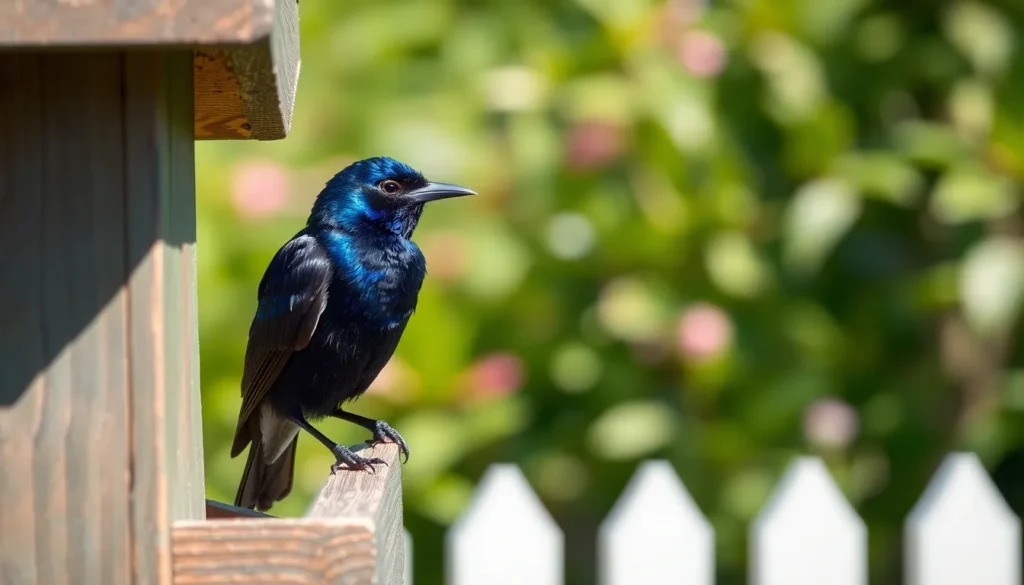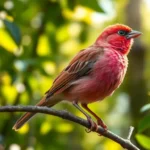We’ve all spotted those sleek birds diving and swooping through the summer sky but many of us don’t realize we’re watching one of nature’s most fascinating aerial acrobats – the martin. These remarkable birds aren’t just pretty to watch; they’re incredible insect-hunting machines that can consume thousands of mosquitoes and flies in a single day.
Martins belong to the swallow family and they’re true marvels of evolution. With their distinctive forked tails and streamlined bodies they’ve mastered the art of catching prey mid-flight while performing breathtaking aerial maneuvers that would make any pilot jealous. Whether it’s the Purple Martin gracing our backyard houses or the Sand Martin nesting along riverbanks these birds have captured our hearts for generations.
What makes martins truly special isn’t just their flying prowess – it’s their remarkable relationship with humans. We’ll explore how these intelligent birds have adapted to urban environments and why creating martin-friendly spaces benefits both our feathered friends and our communities.
What Is a Martin Bird?
Martins represent a specialized group within the swallow family Hirundinidae, distinguished by their robust build and exceptional aerial hunting capabilities. These remarkable birds have evolved exact adaptations that set them apart from their swallow relatives.
Physical Characteristics and Identification
Martins display distinctive physical features that make identification straightforward for birdwatchers. Adult Purple Martins measure 7.5 to 8 inches in length with wingspans reaching 15 to 16 inches. Males exhibit glossy blue-black plumage that appears iridescent in sunlight, while females show darker upperparts with grayish-brown underparts.
Body structure reflects their aerial lifestyle with broad chests housing powerful flight muscles. Wings appear triangular and pointed, designed for swift maneuvers during insect pursuit. Tail feathers form a slightly forked shape, providing enhanced steering control during flight.
Beaks remain short and wide with large gape openings that function like nets for catching flying insects. Eyes position laterally on their heads, offering excellent peripheral vision for spotting prey. Legs appear relatively short and weak, as martins spend minimal time walking on ground surfaces.
Weight ranges from 1.6 to 2.1 ounces for healthy adults, with seasonal variations based on food availability and breeding cycles.
Martin Bird vs Other Swallows
Martins differ significantly from other swallow species in multiple key aspects. Size represents the most obvious distinction, as martins rank among the largest members of the swallow family. Tree Swallows measure only 5 to 6 inches compared to martin’s 8-inch length.
Habitat preferences separate martins from their relatives through their colonial nesting behavior. Bank Swallows create individual burrows in earthen banks, while martins establish large communal colonies in purpose-built housing structures. Cliff Swallows build mud nests under building eaves, contrasting with martin’s preference for enclosed cavities.
Flight patterns reveal behavioral differences between species. Martins soar at higher altitudes ranging from 150 to 500 feet during hunting expeditions. Barn Swallows typically fly closer to ground level at 6 to 20 feet above surfaces.
Dietary focus varies among swallow family members based on hunting strategies. Martins consume larger flying insects including dragonflies, beetles, and flying ants. Tree Swallows supplement insect diets with berries during cold weather, while martins maintain strict insectivorous feeding habits.
Nesting timing distinguishes martins through their later arrival patterns. Purple Martins return from South American wintering grounds between February and May, arriving weeks after other swallow species have established territories.
Types of Martin Birds
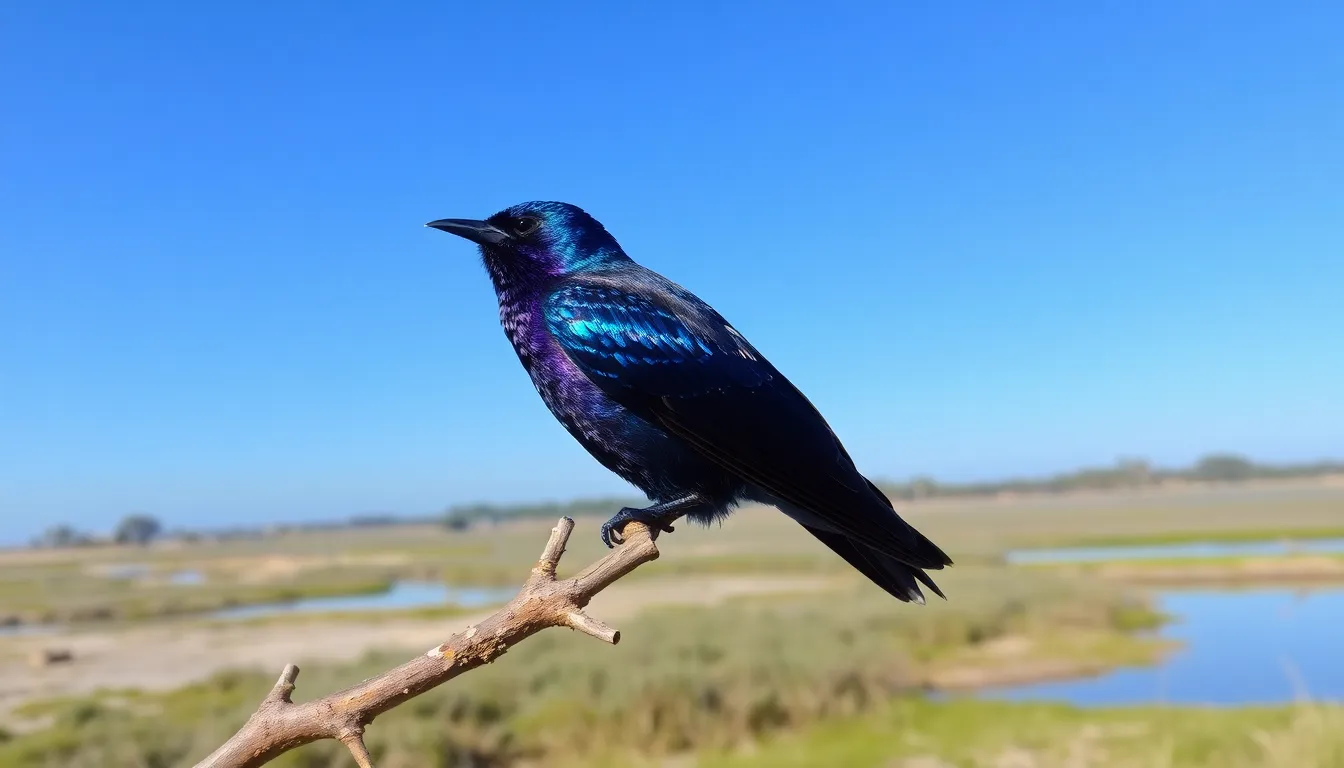
Martin birds cover several distinct species, each adapted to exact environments and hunting strategies. We examine the three primary martin species that showcase the diversity within this remarkable bird family.
Purple Martin
Purple martins represent the largest members of the North American swallow family, measuring 8 inches in length with a wingspan reaching 15 inches. Males display striking iridescent purple-blue plumage that appears almost black in poor lighting conditions, while females exhibit darker backs with grayish bellies and throats.
These aerial specialists consume approximately 2,000 flying insects daily, including beetles, flies, moths, and flying ants. Purple martins arrive in southern regions during January and February, reaching northern territories by April and May. Their migration spans from Canada to Brazil, covering distances exceeding 5,000 miles.
Colony nesting defines purple martin behavior, with groups ranging from 12 to 200 pairs in artificial housing structures. We observe their preference for open areas near water sources, including lakes, rivers, and suburban neighborhoods. Their flight patterns involve continuous aerial foraging at heights between 150 to 500 feet above ground.
Sand Martin
Sand martins measure 4.7 to 5.5 inches in length, making them the smallest martin species in North America. Brown upperparts contrast with white underparts marked by a distinct dark breast band. Their forked tails and narrow wings enable rapid directional changes during insect pursuit.
These birds excavate tunnels 24 to 39 inches deep in sandy banks, riverbanks, and quarry walls. Colony sizes range from 10 to 2,000 pairs, with each pair digging individual burrows. Sand martins consume small flying insects including midges, aphids, and small flies.
Migration timing places sand martins among the earliest spring arrivals, appearing in southern regions during March and reaching northern territories by April. Their wintering grounds extend throughout South America, with some populations traveling 6,000 miles annually.
House Martin
House martins display distinctive white rumps that contrast sharply with their glossy blue-black upperparts and pure white underparts. Measuring 5 inches in length with a wingspan of 10.5 inches, these compact birds feature short, forked tails and broad-based wings.
Mud construction characterizes house martin nesting behavior, with pairs building enclosed cup-shaped nests under building eaves, bridge structures, and cliff overhangs. Each nest requires 1,000 to 1,500 individual mud pellets collected from puddles, pond edges, and wet soil areas.
Their diet consists primarily of small aerial insects caught at heights between 20 to 200 feet. House martins demonstrate remarkable site fidelity, returning to identical nesting locations across multiple breeding seasons. Colony formations typically include 5 to 50 pairs, though larger aggregations occur in optimal habitat conditions.
Martin Bird Habitat and Distribution
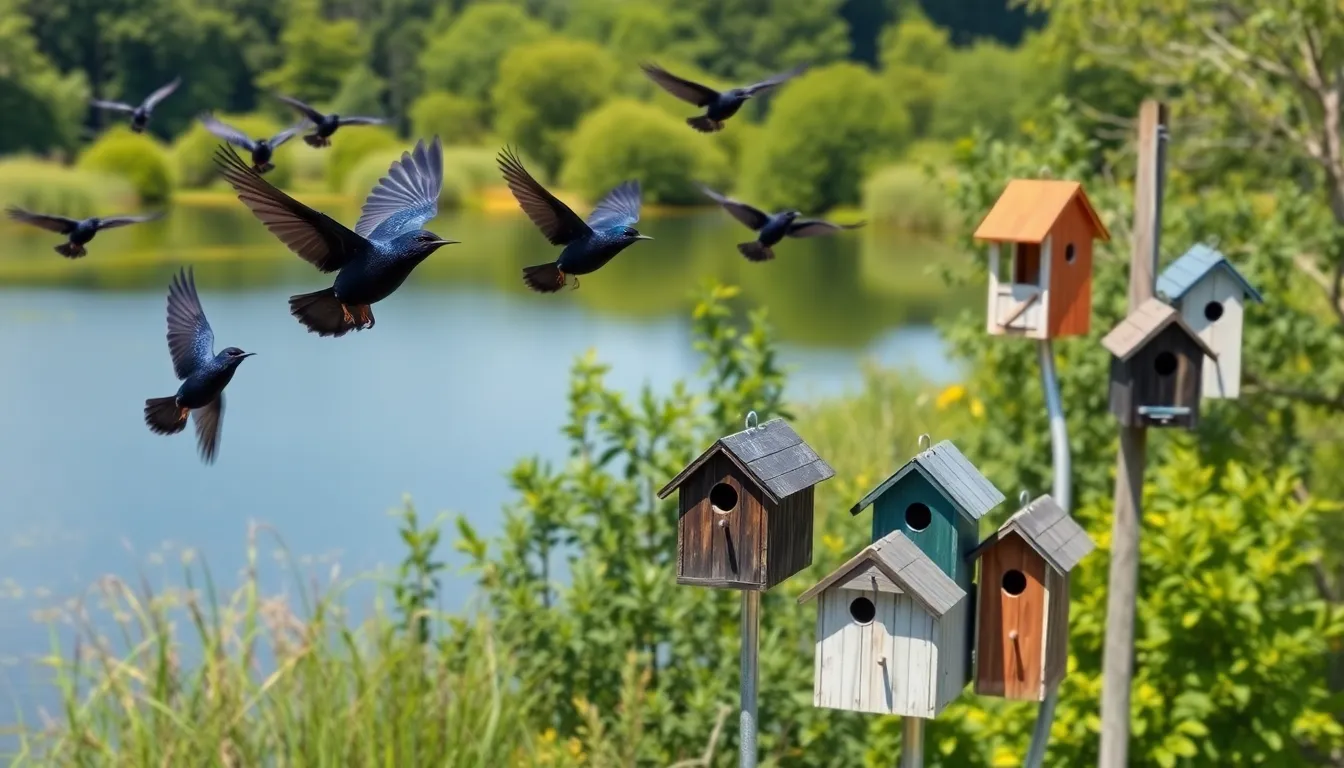
Martin birds occupy diverse habitats across multiple continents, adapting to both natural and human-modified environments. We find these aerial specialists thriving in locations that provide abundant flying insects and suitable nesting sites.
Preferred Nesting Locations
Colonial nesting defines martin bird behavior, with most species establishing communities rather than solitary pairs. Purple Martins demonstrate strong preference for human-provided housing such as multi-compartment birdhouses, gourds, and apartment-style structures mounted 12 to 20 feet above ground. Open areas near water sources attract these birds because insects concentrate in such locations.
Sand Martins excavate horizontal tunnels 24 to 36 inches deep in sandy banks, quarries, and coastal cliffs. Each tunnel terminates in a chamber lined with feathers and grass where the birds lay their eggs. Colonies can contain anywhere from 10 to several hundred nesting pairs depending on available bank space.
House Martins construct cup-shaped nests from mud pellets attached to building eaves, bridges, and cliff faces. These birds collect approximately 1,000 mud pellets to complete a single nest, working primarily during morning hours when mud consistency remains optimal. Urban environments provide abundant nesting sites, making House Martins common in cities and towns throughout their range.
Agricultural landscapes support all martin species by offering extensive foraging areas and reduced pesticide exposure compared to intensive farming regions. Wetlands, lakes, and rivers create ideal hunting grounds where insects emerge in large numbers during warm weather.
Migration Patterns
Long-distance migration characterizes most martin species, with birds traveling thousands of miles between breeding and wintering grounds. Purple Martins depart North American breeding areas between July and September, flying to South American wintering territories in Brazil, Bolivia, and northern Argentina.
| Species | Breeding Range | Wintering Range | Migration Distance |
|---|---|---|---|
| Purple Martin | North America | South America | 5,000-7,000 miles |
| Sand Martin | Europe/Asia | Sub-Saharan Africa | 4,000-6,000 miles |
| House Martin | Europe/Asia | Sub-Saharan Africa | 3,000-5,000 miles |
European martins follow different timing patterns, with Sand Martins arriving at breeding grounds in March and April while House Martins return slightly later in April and May. These birds concentrate along major flyways such as the East Atlantic route, funneling through Gibraltar and the Sahara Desert during migration.
Weather patterns significantly influence martin migration timing, with favorable winds accelerating journey speeds while storms can delay arrivals by several weeks. Birds track insect emergence cycles, timing their return to coincide with peak prey availability in breeding territories.
Stopover sites provide crucial refueling opportunities during long flights, with martins congregating at locations offering abundant insects and safe roosting areas. Major river valleys, coastal regions, and mountain passes serve as important migration corridors where thousands of birds gather before continuing their journeys.
Behavior and Diet

Martins demonstrate complex behavioral patterns centered around their exceptional aerial hunting abilities and sophisticated social dynamics. These remarkable birds exhibit feeding strategies and group behaviors that distinguish them from other members of the swallow family.
Feeding Habits and Prey
Martins capture insects exclusively through aerial hunting, spending 70% of their active hours pursuing flying prey at altitudes between 150 and 400 feet. We observe these skilled hunters consuming an average of 2,000 insects per day during peak season, with individual birds capable of eating up to 3,000 insects when feeding nestlings.
Flying ants, beetles, flies, mosquitoes, and termites comprise the primary components of martin diets. Purple Martins target larger insects like dragonflies and flying beetles, while Sand Martins focus on smaller prey including gnats and midges. House Martins demonstrate versatility by catching both small and medium-sized flying insects throughout different elevations.
Weather conditions directly influence martin feeding patterns, with optimal hunting occurring during warm afternoons when insect activity peaks. We find that martins adjust their hunting altitudes based on barometric pressure, flying lower before storms when insects descend closer to ground level. Dawn and dusk feeding sessions typically last 45 to 90 minutes, coinciding with increased insect movement during these transitional periods.
Foraging territories extend 2 to 5 miles from nesting sites, with individual birds returning to the same productive hunting areas repeatedly. Martins exhibit remarkable memory for locations where insect concentrations are highest, often following the same flight patterns daily when conditions remain favorable.
Social Structure and Flocking
Martins maintain complex colony structures with established hierarchies that determine nesting site access and breeding success. Dominant pairs claim the most desirable nest locations, typically those offering optimal protection and ventilation within communal housing structures.
Colony sizes vary significantly among species, with Purple Martin colonies ranging from 12 to 200 pairs in artificial housing structures. Sand Martin colonies contain 50 to 2,000 breeding pairs clustered in riverbank excavations, while House Martin colonies consist of 5 to 50 pairs sharing building eaves and overhangs.
Communication within colonies involves distinct vocalizations including territorial songs, alarm calls, and contact notes used during foraging flights. We identify 7 primary call types that serve different social functions, from mate attraction to predator warnings. Dawn choruses can last 30 to 45 minutes as colony members coordinate daily activities through synchronized vocalizations.
Cooperative behaviors emerge during predator encounters, with entire colonies mobbing threats like hawks, owls, and snakes that approach nesting areas. Individual martins take turns as sentries while others forage, creating an effective early warning system that benefits all colony members.
Juvenile martins remain with parents for 25 to 35 days after fledging, learning hunting techniques and social behaviors essential for survival. Young birds practice aerial maneuvers in groups before joining adult foraging flights, gradually developing the precision required for successful insect capture.
Martin Bird Nesting and Reproduction
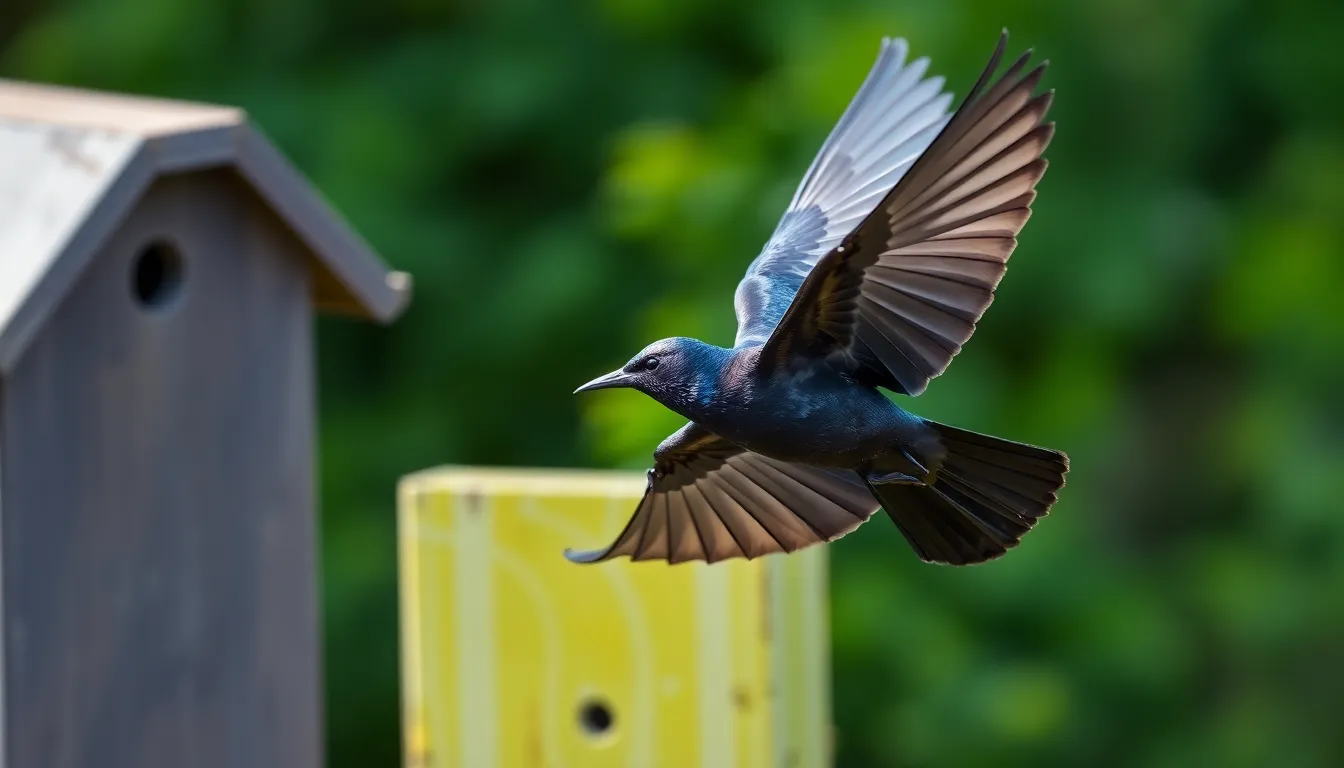
Martin birds exhibit complex reproductive behaviors that vary significantly among species, with breeding cycles closely tied to seasonal insect abundance and weather patterns. We observe distinct courtship rituals and nesting strategies that have evolved to maximize reproductive success in diverse environments.
Breeding Season and Courtship
Purple Martins begin their breeding season between March and April depending on their geographic location. Males arrive at colony sites 4 to 6 weeks before females to establish territories and inspect potential nesting compartments. Territory establishment involves aggressive displays where dominant males claim the most desirable nest boxes through aerial chases and vocalizations.
Courtship displays feature elaborate aerial acrobatics performed by males to attract females. Males execute figure-eight flight patterns while producing distinctive dawn songs that can last up to 3 hours daily. Female Purple Martins select mates based on territory quality rather than male physical characteristics, with premium nest sites located 10 to 15 feet above ground receiving priority.
Sand Martins initiate breeding activities in April when they return to established colony sites along riverbanks and quarries. Males excavate preliminary tunnel entrances in sandy substrates to demonstrate their excavation abilities to prospective mates. Courtship involves ritualized feeding where males present captured insects to females as nuptial gifts.
House Martins start their breeding cycle in late April through May after completing their migration from African wintering grounds. Pair formation occurs through synchronized flight displays where potential partners mirror each other’s movements. Males collect mud pellets and present them to females as part of their courtship behavior, demonstrating their commitment to nest construction.
Nest Construction and Egg Laying
Purple Martin nest construction begins immediately after pair bonding, with both sexes gathering nesting materials within a 100-yard radius of their colony. Nest materials include green leaves, twigs, paper, string, and feathers arranged in a circular depression inside artificial nest compartments. Construction takes 5 to 7 days to complete, with nests measuring approximately 6 inches in diameter.
Egg laying commences 3 to 5 days after nest completion, with females producing clutches of 3 to 6 glossy white eggs. Incubation lasts 15 to 16 days and is performed exclusively by females, while males provide food during this period. Purple Martin females can produce second broods in southern regions when environmental conditions remain favorable.
Sand Martin pairs excavate horizontal tunnels extending 24 to 36 inches into sandy banks or artificial substrates. Excavation requires 10 to 18 days of continuous work, with both birds alternating digging duties using their bills and feet. Completed tunnels terminate in rounded chambers lined with grass, feathers, and other soft materials.
Sand Martin females lay 3 to 5 pure white eggs directly on the nest material without constructing raised nest structures. Incubation spans 14 to 16 days with both parents sharing duties, though females spend more time on the eggs during daylight hours.
House Martin nest construction involves collecting wet mud from puddles, stream edges, and other water sources within 500 meters of the nest site. Pairs work together to build cup-shaped structures attached to building eaves, bridges, or cliff faces using 750 to 1,400 individual mud pellets. Construction requires 8 to 12 days depending on weather conditions and mud availability.
House Martin females deposit 2 to 5 white eggs with occasional brown speckles in their completed mud nests. Incubation lasts 13 to 19 days with both sexes participating, though females assume primary incubation responsibilities. House Martins commonly attempt second and occasionally third broods during extended breeding seasons.
Attracting Martin Birds to Your Yard
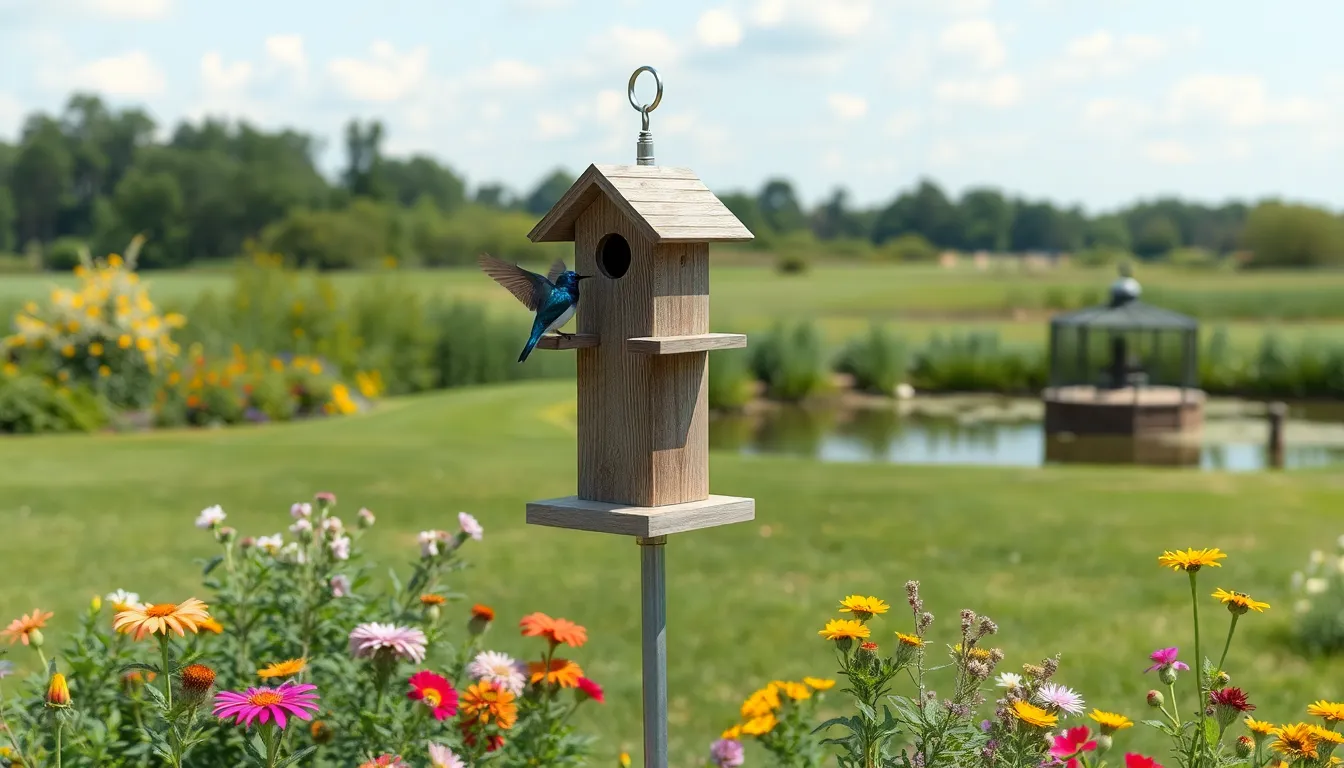
Creating the perfect environment for martin birds requires strategic planning and understanding their exact housing preferences. These remarkable aerial hunters depend on properly designed and positioned accommodations to establish thriving colonies in residential areas.
Martin House Setup and Placement
Location Selection
Martin houses perform best when positioned 30-120 feet from human dwellings in open areas with minimal tree coverage. We position houses at heights between 12-20 feet to provide optimal visibility and protection from ground predators. Clear flight paths extending 40 feet in all directions allow martins to execute their signature aerial maneuvers while approaching nesting sites.
Housing Specifications
Purple Martin houses feature compartments measuring 6x6x6 inches with 2.125-inch entrance holes positioned 1 inch above the floor. Each compartment accommodates one breeding pair, with successful colonies housing 8-20 pairs in multi-unit structures. We install houses with removable panels for seasonal cleaning and maintenance access.
Mounting Systems
Telescoping poles with pulley systems enable easy house lowering for cleaning and monitoring activities. Pole guards consisting of smooth metal sleeves prevent climbing predators like snakes and raccoons from accessing nesting compartments. We anchor poles using concrete footings extending 2-3 feet underground for structural stability.
Site Preparation
Martin colonies thrive near water sources within 1-2 miles, including ponds, lakes, or wetland areas where flying insects concentrate. We maintain grass heights below 6 inches within 40 feet of housing structures to help martin landing and takeoff patterns. Nearby agricultural fields and meadows provide additional foraging opportunities throughout the breeding season.
Best Practices for Martin Conservation
Timing Installation
Martin house installation occurs during winter months between December and February, allowing structures to weather naturally before spring arrivals. We position houses facing southeast to capture morning sunlight while providing afternoon shade protection. Early installation prevents other cavity-nesting species from claiming compartments before martins return.
Competitor Management
European Starlings and House Sparrows frequently compete for martin housing compartments due to similar size requirements. We install starling-resistant entrance holes measuring exactly 2.125 inches to exclude larger competitors while accommodating martin access. Regular monitoring during April and May enables prompt removal of non-native species and their nesting materials.
Maintenance Schedules
Annual house cleaning removes old nesting materials and parasites that accumulate between breeding seasons. We perform thorough compartment inspections during fall months, replacing damaged panels and tightening mounting hardware. Fresh coats of white paint every 2-3 years reflect heat and maintain compartment temperatures below harmful levels.
Colony Monitoring
Weekly observations during breeding season help identify successful nesting pairs and potential problems requiring intervention. We document arrival dates, nesting progress, and fledgling counts to track colony health over multiple seasons. Temperature monitoring ensures compartment conditions remain between 70-85°F during critical breeding periods.
Habitat Enhancement
Native plant landscaping creates insect habitat supporting martin dietary requirements throughout the breeding season. We establish wildflower gardens and native grass areas within 100 yards of housing structures to attract flying insects. Avoiding pesticide applications within 200 yards of martin colonies preserves essential food sources during critical nesting periods.
Conclusion
Martin birds truly showcase nature’s remarkable adaptability and aerial mastery. These fascinating creatures have evolved unique strategies for survival while maintaining their essential role as natural pest controllers in our ecosystems.
We’ve seen how their specialized hunting abilities and social behaviors make them exceptional neighbors for humans. By understanding their needs and creating supportive environments we can help ensure these remarkable birds continue to thrive in our shared spaces.
The bond between martins and humans represents a beautiful example of coexistence. Whether you’re planning to install martin housing or simply appreciating their aerial displays these birds remind us of the incredible diversity and wonder that exists right in our own backyards.
Frequently Asked Questions
What are martins and how are they different from other swallows?
Martins are specialized birds within the swallow family Hirundinidae, distinguished by their robust build and exceptional aerial hunting skills. They’re among the largest swallows, measuring 7.5-8 inches, with broad chests and pointed wings. Unlike other swallows, martins prefer communal colony nesting, focus on larger flying insects, and arrive later in spring migration seasons.
What are the main types of martin species?
The three primary martin species are Purple Martins (largest at 8 inches with iridescent plumage), Sand Martins (smallest at 4.7-5.5 inches, known for burrowing in sandy banks), and House Martins (5 inches, famous for mud nest construction). Each species has unique adaptations, nesting behaviors, and hunting strategies suited to their specific environments.
Where do martins typically nest and live?
Martins adapt to both natural and human-modified environments. Purple Martins prefer human-provided housing, Sand Martins excavate tunnels in sandy banks and cliffs, while House Martins build mud nests on buildings. They favor agricultural landscapes and wetlands for foraging, often forming large communal colonies in their chosen nesting areas.
How far do martins migrate?
Martins undertake impressive long-distance migrations. Purple Martins travel up to 7,000 miles to South America for winter, while Sand and House Martins migrate to Sub-Saharan Africa. Migration timing depends on weather patterns and insect availability, with birds using crucial stopover sites to refuel during their extensive journeys.
What do martins eat and how do they hunt?
Martins are exclusively aerial hunters, spending 70% of their active hours pursuing flying insects. They consume approximately 2,000 insects daily, including flies, mosquitoes, beetles, and flying ants. Each species has specific dietary preferences, and their hunting patterns are significantly influenced by weather conditions and insect availability.
How can I attract martins to my backyard?
To attract martins, install proper housing 12-20 feet high in open areas, at least 40 feet from trees. Purple Martins need multi-compartment houses, while other species prefer different setups. Maintain chemical-free landscapes, provide water sources, and install houses before breeding season. Regular maintenance and competitor management are essential for success.
What is the breeding behavior of martins?
Martin breeding seasons vary by species, typically beginning March-April. Males establish territories through aerial displays and vocalizations to attract females. Courtship includes ritualized feeding and synchronized flights. Both parents collaborate in nest building, egg incubation (lasting 12-16 days), and raising young, with juveniles learning essential survival skills before independence.
How do martins benefit the environment?
Martins provide significant ecological benefits as natural pest controllers, consuming thousands of flying insects daily. This helps reduce mosquito and agricultural pest populations without chemicals. Their presence indicates healthy ecosystems, and they contribute to biodiversity. Supporting martin populations through proper housing and habitat conservation helps maintain ecological balance in local environments.

